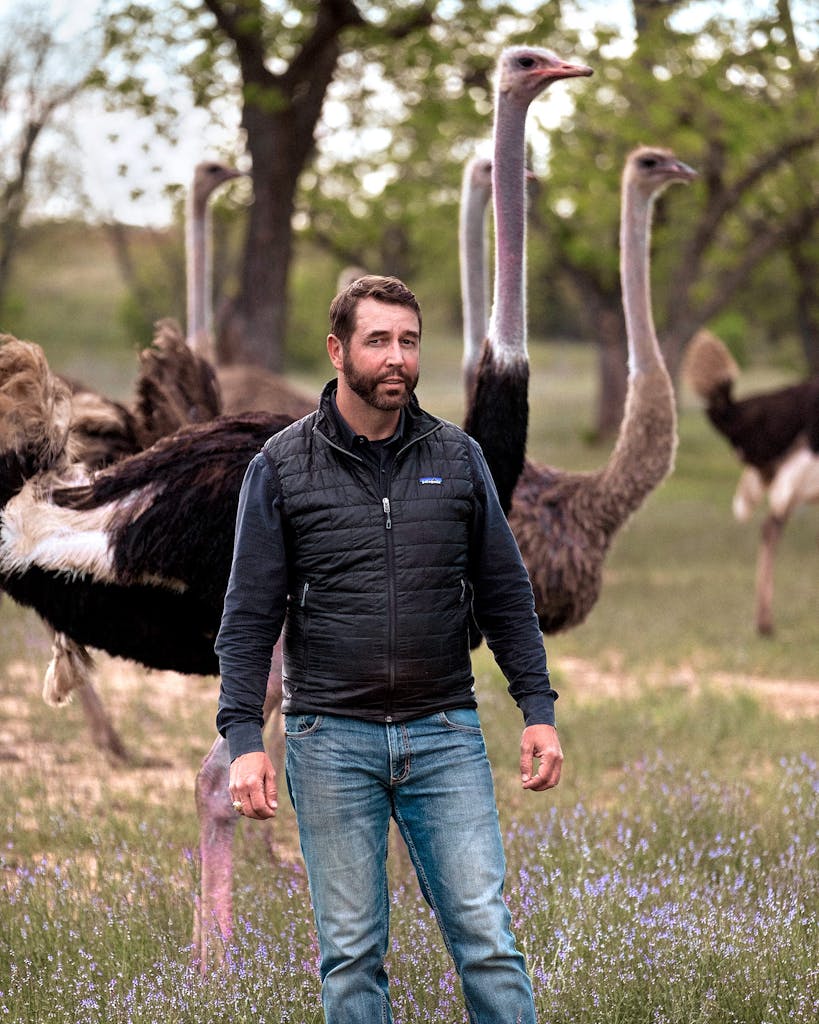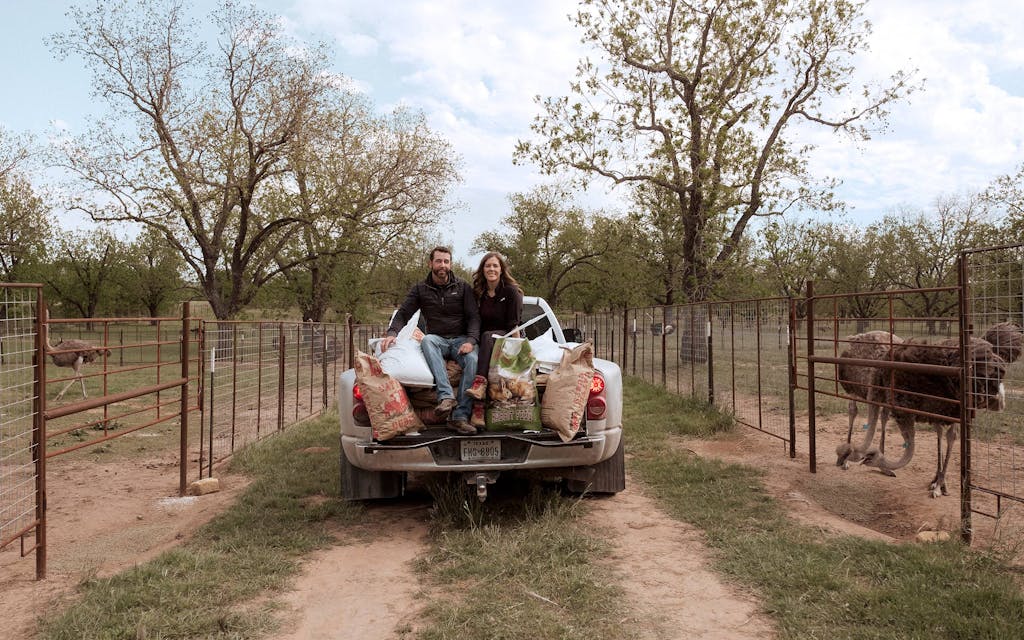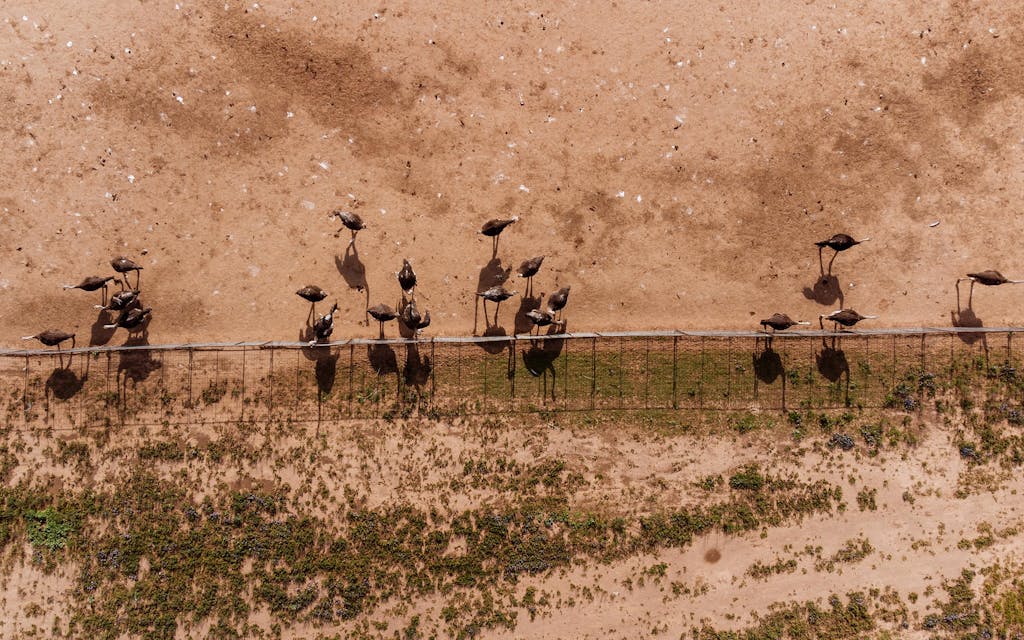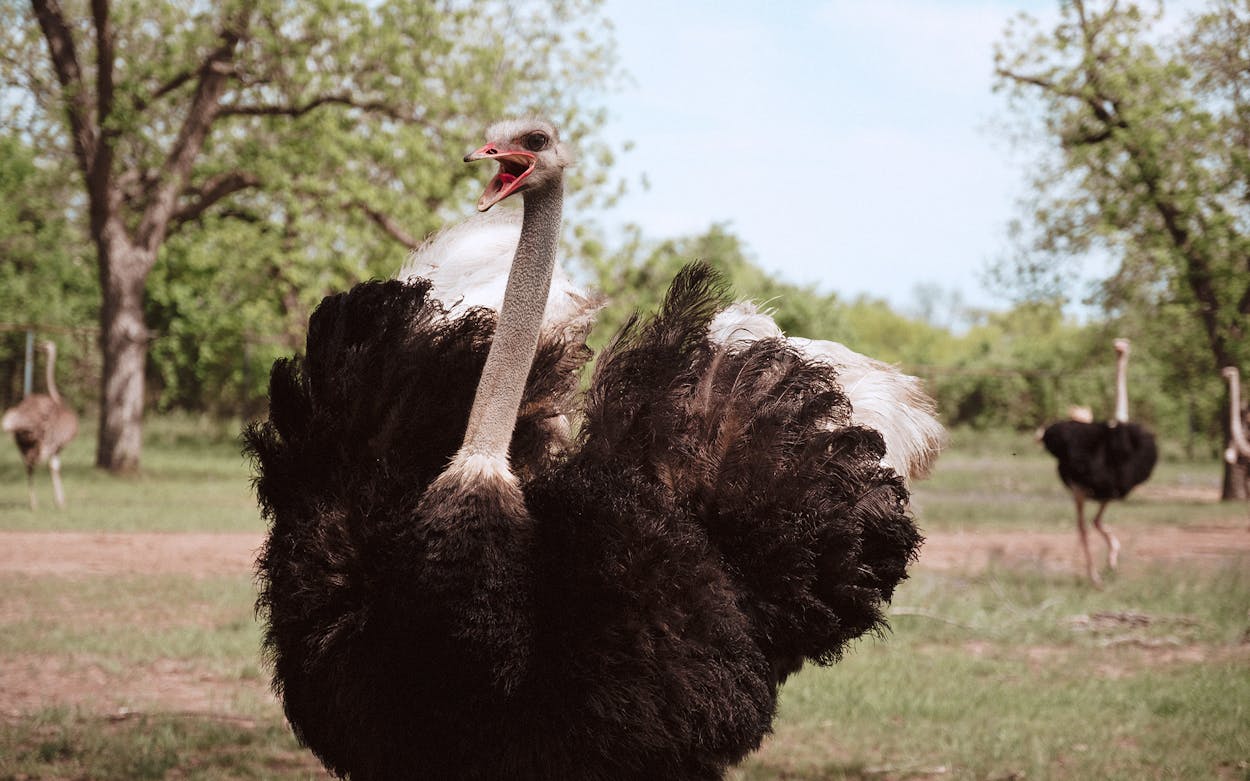When the ostrich reached in to nip at his collar, Boyd Clark bopped it gently in the face with his cowboy hat. The bird drew back, seemingly affronted. The rest of Clark’s flock of yearlings—each already over eight feet tall—swirled around him like feather dusters. Then they pressed back in, looking for a meal.
“Sometimes I’ll be out here working on something, repairing the fence, and they’ll all be around, pecking at my ears or the back of my neck,” said Clark, an easygoing, bearded man dressed in a puffy vest. “It gets a bit old.”
At first glance, ostriches might not seem like promising livestock. An African member of the ratite family—a group of flightless, shaggy-feathered birds that also includes the Australian emu and the South American rhea—the ostrich is the largest of the living dinosaurs, with two-toed feet, clawed fingers discreetly tucked beneath its wing feathers, and the largest eyes of any land animal. Stately at a distance and comical up close, ostriches are unexpectedly formidable. Adults can tower up to nine feet and weigh as much as 320 pounds; they can hit speeds of 45 miles per hour at a sprint and kill a lion with a single kick.
But an ostrich can also be turned into all sorts of useful products: red meat, a tough hide, and luxurious feathers. At Clark Ostrich Farm, a hundred-acre fenced property in Bend, an unincorporated Hill Country town on a bend of the Colorado River, Clark and his family run a part-time business breeding and raising birds for their meat.
In October, about seven hundred ostriches of various ages wandered among the century-old pecan trees, larger Maasai red-necks mingling with the smaller, slightly more docile South African blue-necks. In the barn, the last hatchlings of the season, as fat and fluffy as teddy bears, clustered beneath red heat lamps. In the breeding pens, Clark pointed out the openings at the bottoms of the fences that allow him to speedily duck out of the enclosures when collecting eggs. “The ones we hatched ourselves are more comfortable with humans, so they’re more aggressive” when it comes to protecting their nests, he said. “Sometimes you have to move pretty fast.”

With no eggs to protect, the 26 laying hens and their accompanying roosters kept a wary distance as we passed. The birds in the main paddock weren’t as nervous. While a few held back when we climbed out of Clark’s silver pickup, uttering low grunts of alarm, a mob rapidly coalesced around us, heads bobbing, and the shakedown commenced. Within five minutes I had been comprehensively nibbled. As a dog sniffs or a child pokes, Clark said, ostriches peck, perhaps out of a touching optimism that this time, the buttons, phones, shirt collars, hat brims, or masks might prove to be edible.
The oldest birds in the paddock date back to the early eighties, when Clark was first starting out as an ostrich farmer. The birds and Clark are some of the few survivors of one of the most extraordinary bubbles in Texas and American agricultural history: a brief period in the early nineties when rural Texans went crazy for emus and ostriches. The notion that there was a vast untapped market for ostrich meat and ostrich leather drove countless Texans, from hobby ranchers to big-time investors, to buy and breed the big, goofy birds. Unwary doctors and lawyers put their savings into flipping ostriches; trucks full of nervous birds trundled toward slaughterhouses, where inexperienced processors struggled to harvest valuable hides. By 1995 the industry was a smoking ruin. Many of its proponents had filed for bankruptcy, and the idea of the American ostrich was a punch line—one more speculative nineties bubble, like Beanie Babies or the dot-com boom.
Clark weathered the storm: he kept his operation small, kept his day job, and kept his birds. Today, he’s one of just a few veteran ostrich breeders who believe the industry may still have a future. The question is what kind—and whether it’s really possible to get the ostrich industry off the ground.
In 1985, when a fourteen-year-old Boyd Clark bought his first clutch of $15-apiece ostrich eggs from a local exotics rancher in Bend, most ostriches in America lived either in zoos or as novelties on game ranches. Clark, an outdoorsy kid with a fondness for birds, raised the birds as part of a Future Farmers of America project, then kept breeding them on his own for the fun of it. A year later, Congress passed the Comprehensive Anti-Apartheid Act, which limited trade with South Africa—where the ostrich industry had been born, in the 1860s—in an effort to undercut its racist government. The supply of ostrich products from South Africa was abruptly cut off during a period of high demand. As a result, ostriches in the U.S. were suddenly fetching very high prices.
Though Clark was still too young to appreciate how his hobby had turned into a business, others were ready to take advantage. To Tom Mantzel, a tall, garrulous Fort Worth oilman and exotic-animal breeder, the sanctions gave American ranchers an opportunity to make a play for the global ostrich industry. Mantzel, then 41, dove into the ostrich import business in 1988, securing egg-collection permits from the Tanzanian government and paying kids from Maasai tribes for tips about wild ostrich nests. The eggs were hatched in a facility under the white peaks of Kilimanjaro, and the chicks were eventually shipped to Mantzel’s ranch in McAllen, where he bred the birds for meat and leather.


Ostrich products, Mantzel argued, were a sure thing: by breeding more birds, ranchers could increase demand and eventually kick-start a profitable industry. In 1988 he founded the American Ostrich Association to promote the practice of ostrich ranching and to market the birds themselves. Many ranchers were easily enticed. The prior decade had seen a nationwide farming crisis, spurred in part by record agricultural production pushing prices down. By 1989, the association had five hundred members, most of them Texan. “I tell ranchers, ‘Just set aside 1 percent of your land, two or three acres, and raise ostriches,’ ” Mantzel told the AP that year. “I say, ‘Instead of spending a dollar and a dime to make a dollar, try something you can make a profit on.’ ”
With few ostriches available and demand skyrocketing, prices shot up. A breeding pair of birds now sold for anywhere from $30,000 to $80,000, while eggs Clark had once bought for $15 each now went for $3,000. The timing of the boom couldn’t have been better for Clark, who was paying for his bachelor’s degree at Texas A&M University by selling yearlings, which were now fetching $10,000 each. His clients were large farms investing in breeding stock or brokers who planned to flip them to other sellers. Before long he’d made around $300,000. “I just couldn’t believe it was happening,” Clark said. “Imagine someone calling you up to buy an ostrich for $5,000, and then, later that day, someone else calls and offers you $7,000, and then someone else buys it for $8,000. It was like a fever.”
In 1993, a 21-year-old Clark—who’d joined the American Ostrich Association a few years earlier—got voted onto the board of directors, a position he still holds. It was a heady year. Thousands attended an industry convention in Fort Worth, where vendors hawked incubators, and ranchers from South Africa gave tips on the finer points of ostrich raising.
If anyone had reason to be excited about the ostrich business, it was Clark. In a few short years, he’d made enough money to put himself through college and buy his hundred acres in Bend. But for all the excitement of the time, Clark said, he began to feel that the whole thing was spinning out of control. “Everyone thought there was no end in sight. But as the market went up, I saw a lot of people were just trying to buy chicks, grow ’em a few months, and flip ’em. There were people getting in that really had no business being in ostriches—a lot of city people, doctors, lawyers. They saw there was supposedly easy money.”

The year 1993 proved to be the high-water mark for ostrich mania. The ostrich association estimated that 50,000 birds roamed on 3,500 farms across the United States that year. Speculators had also roped in the Australian emu: breeding pairs hit $40,000 at the peak of the bubble, and emu farms proliferated rapidly across the Texas countryside, eventually outnumbering ostrich operations. With so much money changing hands, ostrich rustlers and fraudsters rushed in. Dallas-based International Breeders Inc., which sold shares on nonexistent breeding operations through high-pressure cold calls, was one of several companies that harvested a combined $6.5 million before the Securities and Exchange Commission shut them down in 1995. Meanwhile, many new ranchers had little to no experience in agriculture. Novices soon discovered that ostriches were finicky to breed and took ranchers’ attempts to harvest their eggs extremely personally. The hatchlings—as one anonymous South African rancher complained to the New York Times in 1997—went “looking for things to die of.”
Husbandry was the least of an ostrich farmer’s woes, however. Mantzel’s goal had been to build up a supply of birds and then start processing them for meat and leather. But the few hundred processing plants able to handle ostriches and emus were scattered throughout the country, and large birds do not travel as well as cattle. Without widespread processing facilities, nobody could guarantee a consistent supply of meat. Soon, the few restaurants that had stocked the flightless bird dropped it from their menus.
Attempts to get American ostrich leather off the ground also ran into serious problems. Mantzel had begun acting as a broker between ranchers, meat processors, and a tannery in Mexico. Many of the hides the tannery received were disasters, Mantzel said, with some arriving at the plant already rotten. Even the tannery’s best work simply couldn’t approach the quality of hides produced in South Africa. “Nobody knew how to process or sell them,” Mantzell said. “Taking a skin off an ostrich is not like butchering a white-tailed deer . . . If there’s a scar, a cut, or a scratch, basically the boot company doesn’t want anything to do with it.”
With the repeal of American anti-apartheid legislation in 1993, South African ranchers tried to cash in on the American boom, releasing a new wave of birds into the market. By 1995, the global ostrich market had become glutted, and ostriches, once valued for their comparative rarity, dropped in price. Brokers and new ranchers found themselves stuck with expensive, hungry flocks. The bubble popped. Panicking ranchers fled as fast as they could and, in doing so, drove the prices down further still. “You’d see someone trying to sell their $50,000 pair for $40,000, and the guy next to him says, ‘Gosh, I need to get rid of mine for $30,000,’ and you see where that goes,” Clark said.
Mantzel, stung by infighting at the trade association and from the dissolution of several of his African projects, got out in 1995. He had concluded that trying to beat the South Africans at their own game had been a foolish mistake. Now that he was ensconced in the fashion leather business—his company Zelli Handbags opened in the mid-nineties—he began sourcing his leathers from South Africa. “I kept searching for ways to make ostrich ranching work, but it simply wasn’t worth the headache,” he said. “Honestly, talking about it brings back memories that aren’t great.”

By 1997, a breeding pair went for around $500. The dizzying highs were gone, leaving unprofitable farms and thousands of excess birds. Most of the ostriches eventually ended up at slaughterhouses or were sold back to exotic game ranches. But the emu crash was even worse. According to Donald Feare, an Arlington lawyer who runs a bird sanctuary, when the emu market imploded, meat processors simply weren’t able to handle all of the birds. One pair of Dallas doctors—whom Feare unsuccessfully tried to get indicted for animal cruelty in 1997—beat their birds to death with baseball bats. Others left their birds to starve. Some opened their gates and turned the confused emus loose. For years, feral emus haunted the rural byways of Texas, frightening motorists and frustrating sheriff’s departments before they eventually died out.
Clark, meanwhile, weathered the crash. He had been lucky enough to get in on the ground floor and had sunk his money into his college degree and the business itself: the land, the fencing, the barns. When the lean times came, he simply turned the adult ostriches out onto the property and left them to their own devices. But, privately, he wondered if someday the ostrich business could rise again—provided people kept their heads.
Texas ostrich farming got another chance in 2011. An outbreak of avian flu in South Africa had hobbled the country’s ostrich industry, and both demand and prices crept up to match. Many ostrich ranchers who had been badly burned by the crash stayed away. But those few who’d kept their birds, like Clark, cautiously began trying to sell them again.
This time they emphasized the value of the meat. According to the USDA, ostrich cuts are ruby red, high in protein and iron, and lower in calories, cholesterol, and fat than beef. (Clark provided me with a few pieces, which I took home and cooked: the meat tasted something like venison and went quite well with tikka masala.) “People are much more health-conscious of the fat content of the food they’re eating, where it comes from,” said Clark. “That’s been a big driver of the ostrich market today.”
Clark says that ostriches are better suited to Texas’s harsh conditions and drought-prone rangeland than cattle. They also breed faster, require less land to produce, and can be fed with alfalfa, a crop that fixes nitrogen in the soil.
Business eventually picked up enough for Clark to run the farm part-time as a specialty meat business, a side hustle to his day job as a briefing attorney for a federal judge. He occasionally sells birds to exotics ranchers or for special occasions—a farm-to-table restaurant in the Austin suburb of Leander once ordered a whole ostrich for a special event—but most of his birds are processed at a facility in Westphalia, a tiny town east of Temple, and the meat is shipped to wholesalers that supply restaurants such as Wildfire in Georgetown, a saloon-style steakhouse specializing in wild game. Clark recently bought a nearby 140-acre parcel of land in the hopes of expanding the operation, but he’s still haunted by memories of the crash. The infrastructure problems that once plagued the industry have only gotten worse: in the nineties, a few hundred USDA-certified plants processed ostrich; these days, only a dozen do.
“I’m a believer in growing slowly and, if everything’s looking well, then expanding,” said Clark. “There’s some people whose business model is different, who try to get as big as they can as fast as they can. But I think ostriches are an animal that it takes time to learn to raise properly.
Others, however, are betting a commercial market is possible. Among them is Superior Ostrich, a breeding operation located on a 355-acre spread in Valley Mills, near Waco. According to Joe Soto, the company’s treasurer, Superior has spent around $12 million in investment capital over the past few years, $8 million of which comes from Soto’s own private-equity business. After buying up all of the breeding stock they could get their hands on, Soto says, they’ve been mining the expertise of South African investors and working with a newly established meat processing facility near the ranch. The company aims to sell 700 birds next year and expand from there. Cheap ostrich meat won’t be showing up at local groceries anytime soon, but the company hopes to produce a steady 5,000 to 10,000 birds a year by 2025, selling to high-end restaurants and stores.

But whether Americans will bite is an open question. For all the rhetoric about ostrich as a healthier replacement for beef, the bird isn’t likely to dethrone the heavily subsidized cattle industry anytime soon. Ostrich meat is still relatively expensive: $12 a pound on the low end and with higher-end cuts retailing for more than $30, compared to roughly $4 a pound for beef.
And the shadow of the 1990s crash still hangs over the industry. There have been multiple attempts to get homegrown ostrich markets going in Europe and Asia, to say nothing of another speculative bubble around emu ranching in India. Smaller-scale ostrich farming of the sort that Clark practices seems reasonably sustainable, but it remains to be seen whether the more industrial model—the type that Superior Ostrich is working toward—has solid footing.
Mantzel, once the great champion of Texas ostrich ranching, now vehemently dismisses it. Selling ostrich meat could potentially work, he concedes, but the South African ostrich industry has a hundred-year head start on infrastructure and distribution. “What’s the definition of insanity?” Mantzel said. “[American ostrich] is a pipe dream. They can talk about it around drinks every night, but when it comes to putting down cold, hard cash and connecting the dots to a viable product, no, it won’t work. You could knock me over with a feather if it gets airborne.”
Still, there’s something about ostriches that keeps people coming back—the lure of expensive leather shoes, the dream of red meat with no fat, the romance of living dinosaurs. Leaning against Clark’s pickup truck, watching the flock grazing under the pecan trees, it’s easy to see the appeal. The industry might not take wing the way that boosters once dreamed, Clark said. “But it’s definitely got legs.”
- More About:
- Critters






